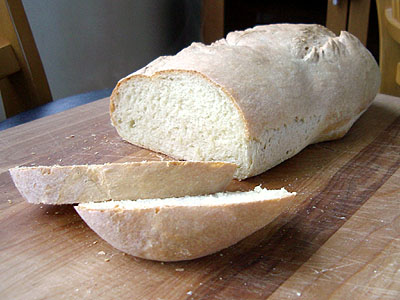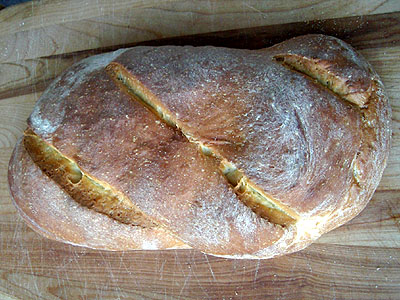Bakers throw around a lot of terms and often don't define them. As I use jargon I'll try to start recording it here for the sake of building up a reference.
ABAA: Artisan Baking Across America, by Maggie Glezer. A book featuring profiles of artisan bakers and recipes for some of their breads.
AP: all purpose
autolyse: a technique for improving gluten development without heavy kneading. Combine the flour and water from your recipe in a bowl and mix until the flour is fully hydrated. Cover the bowl and let the flour hydrate for 20 minutes, then mix in remaining ingredients. The result is development comparable to a dough that has been kneaded for 5 or 10 minutes with less oxydation (which leads to a yellow crumb).
Baker’s percentage:a convention for listing the ingredients in a dough in which the quantity of each ingredient is expressed a percentage of the total amount of flour. Example: 1000g flour, 660g water, 20g salt, 10g yeast is expressed in baker’s percentage as 100% flour, 66% water, 2% salt, 1% yeast. Note that this always adds up to more than 100%.
BBA: The Bread Baker's Apprentice, a book by Peter Reinhart. One of the more popular book among amateur artisan bakers in the United States.
Banneton: a woven basket, sometimes lined with linen, used to hold a shaped loaf while it is proofing.
Batard: a loaf that has an oval or oblong shape.
Biga: a term used variously as a very stiff (~50% hydration preferment), or as a generic term for preferment.
Boule: a round loaf (French for "ball").
Brotform: a coiled cane basket used to hold a shaped loaf while it is proofing.
Couche: heavy linen fabric used to hold formed loaves for proofing. The fabric can be pleated around the loaves to help them hold their shape.
Crumb: When a baker talks about the crumb they are talking about the pattern of holes inside of a loaf.
Fermentation: (1) the process by which yeast metabolizes sugars to produce carbon dioxide and alcohol (2) (aka bulk fermentation, first fermentation) the period of time the dough rests after mixing and before dividing/shaping.
Folding: one of the best ways of encouraging gluten development in slack doughs. Folding the dough consists of taking a wet dough out of the bowl, spreading it out a little on a clean, well-floured surface, folding it in thirds like a letter, rotating it 90 degrees and folding it up again, picking it up and dusting the loose flour off of it, and then returning the dough to the bowl and covering it again. Like punching down, folding degases the dough some, but it also encourages gluten development.
FSWY: Flour Salt Water Yeast, a book by Ken Forkish
Gluten: "A tenacious elastic protein of wheat flour that gives cohesiveness to dough." Gluten is what allows bread dough to develop those long, beautiful strands and create large open pockets of air (think about the inside of a loaf of Ciabatta compared to the inside of a muffin). Bread flours tend to be made from hard wheats that are higher in protein than regular flour, providing more gluten.
Hamelman, Jeffrey: bakery director at King Arthur Flour and author of Bread: A Baker’s Book of Techniques and Recipes, a comprehensive book aimed at both professional and home bakers.
Hydration: the ratio of liquid ingredients (primarily water) to flour in the dough. A dough with 500g of flour and 340g of water has a hydration of 68% (340/500).
KA: Kitchen Aid or King Arthur.
KAF: King Arthur Four.
Lame: a thin blade on a handle, used to score (slash) loaves before baking.
Levain: usually used as a synonym for sourdough.
Leonard, Thom: A baker featured in ABAA whose Country French Bread is popular with many members of The Fresh Loaf.
Pâte fermentée (aka prefermented dough): a type of preferment in which the ingredients (flour, water, yeast, salt) are mixed in the same proportion as (usually) a basic white bread dough at about 65% hydration.
Poolish: A type of sponge. Typically quite wet, an equal weight of water and flour with an extremely small amount of yeast. For my batch of two French Bread loaves, I typically use 8 ounces of water, 8 ounces of bread flour, and 1/8 teaspoon a instant yeast. Mix it, cover the bowl, and leave it at room temperature overnight.
Proof: (1) the final rise of the shaped loaves before baking (2) the hydration of dry active yeast in water before it is added to the dough
RLB: Rose Levy Beranbaum, author of The Bread Bible, a book aimed at the home bread baker.
S & F: S & F can mean "stretch and fold" or "slap and fold." Slap and fold is usually done for about 20 minutes whereas stretch and fold is flipping the dough out and doing one round of folds every 30 minutes, then 30 minutes later at 60 minutes, then 30 minutes later at 90 minutes (after mixing the dough) and again, 30 minutes later at 120 minutes from mixing the dough. After folding the dough is flipped back over and corners tucked under. the dough covered and allowed to rest and rise until the next 30 minutes comes around.
Score (aka slash or dock): to cut the surface of the loaf prior to baking. This provides for controlled expansion of the loaves during baking so they do not “break” undesirably. Scoring is also used to enhance the appearance of the bread.
Sourdough: a preferment that is a culture of wild yeast and bacteria that is perpetuated by the periodic addition of flour and water, or a bread leavened in whole or part by this culture.
sponge: Also known as a "preferment," a sponge is a portion of the ingredients that is mixed ahead of time, typically overnight. Using a sponge extends the fermentation process longer and generally releases more complex flavors in your loaf. It can also be used to soften dry ingredients (such as whole grains) and release sugars from the grains.
WW: whole wheat.


















